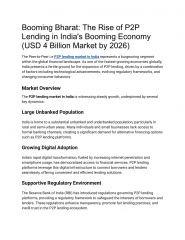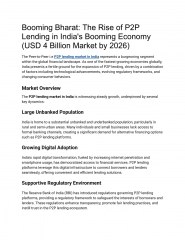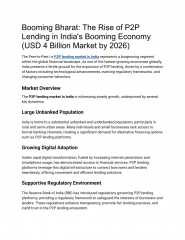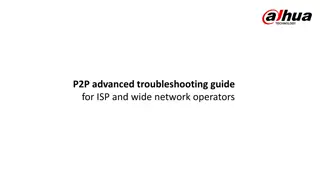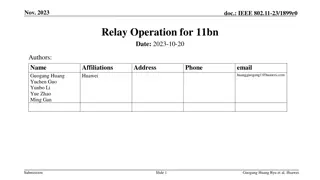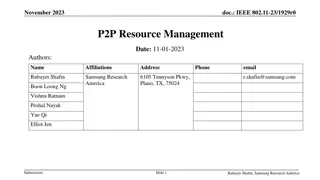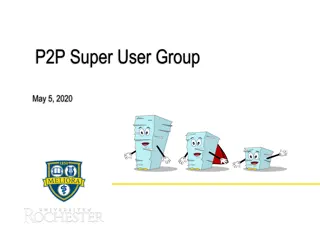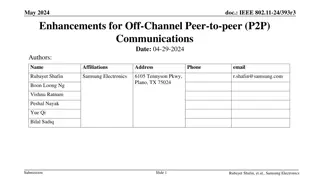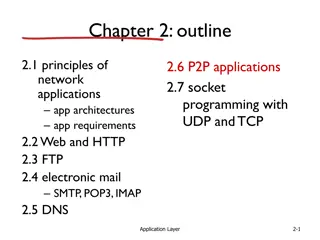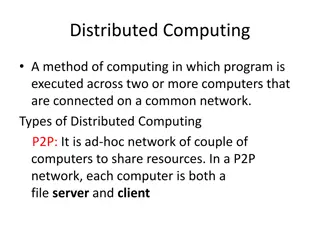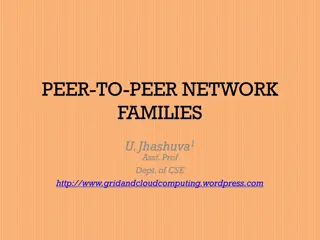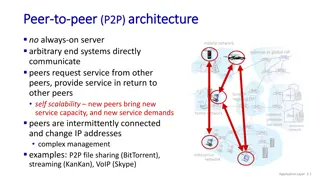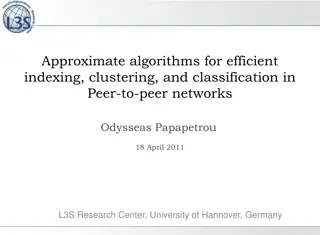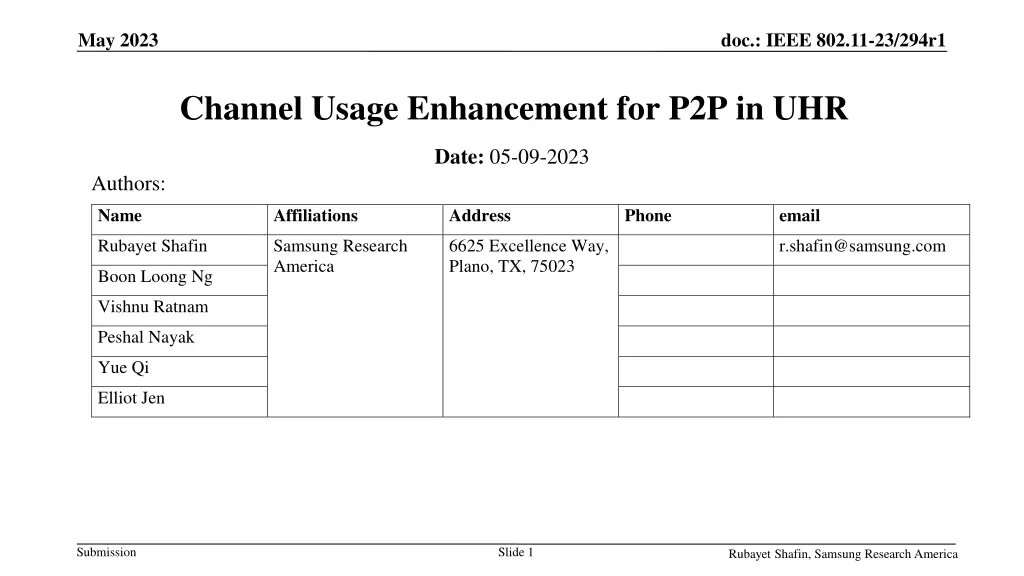
Enhancing P2P Channel Usage in Next-Gen WLAN Systems
Explore a proposal for improving peer-to-peer (P2P) communication in WLAN systems through enhanced channel usage coordination between infrastructure networks and P2P networks, aiming to prioritize low-latency applications and optimize resource utilization. Learn about the motivation, guidance, and recommended strategies for efficient P2P transmission within the IEEE 802.11-23/294r1 framework.
Download Presentation

Please find below an Image/Link to download the presentation.
The content on the website is provided AS IS for your information and personal use only. It may not be sold, licensed, or shared on other websites without obtaining consent from the author. If you encounter any issues during the download, it is possible that the publisher has removed the file from their server.
You are allowed to download the files provided on this website for personal or commercial use, subject to the condition that they are used lawfully. All files are the property of their respective owners.
The content on the website is provided AS IS for your information and personal use only. It may not be sold, licensed, or shared on other websites without obtaining consent from the author.
E N D
Presentation Transcript
May 2023 doc.: IEEE 802.11-23/294r1 Channel Usage Enhancement for P2P in UHR Date: 05-09-2023 Authors: Name Affiliations Address Phone email Rubayet Shafin Samsung Research America 6625 Excellence Way, Plano, TX, 75023 r.shafin@samsung.com Boon Loong Ng Vishnu Ratnam Peshal Nayak Yue Qi Elliot Jen Submission Slide 1 Rubayet Shafin, Samsung Research America
May 2023 doc.: IEEE 802.11-23/294r1 Abstract In [1], we highlighted some of the potential technologies for improved peer- to-peer (P2P) operation. One of the key directions identified for improving P2P support in UHR is to have tighter coordination between the infrastructure network and the P2P networks to ensure their harmonized coexistence. Towards that, in this contribution, we propose a possible enhancement for channel usage [2] to better support P2P communication in WLAN systems. Submission Slide 2 Rubayet Shafin, Samsung Research America
May 2023 doc.: IEEE 802.11-23/294r1 Motivation Next-generation WLAN system needs to provide better support for low- latency applications [3]. Today it is not uncommon to observe numerous devices operating on the same network. Many of such devices may be latency-tolerant but still contend with devices with low-latency applications for the same time and frequency resources. In some cases, the access point (AP) as the network controller may not have enough control over the unregulated/unmanaged traffic that contends with the low-latency traffic within the infrastructure BSS. Some of the unmanaged traffic that interferes with the AP s BSS latency- sensitive traffic may be coming from direct link communications within the infrastructure BSS that the AP manages (i.e. TDLS); some others may be coming from neighboring independent BSS or P2P networks. AP STAs associated with AP UL/DL link Direct link STAs not associated with AP Submission Slide 3 Rubayet Shafin, Samsung Research America
May 2023 doc.: IEEE 802.11-23/294r1 Guidance for P2P transmission The next-generation WLAN system needs mechanisms to better handle the unmanaged P2P traffic This would help protect and prioritize the low-latency traffic in the network If the P2P STAs use a set of time/frequency resources for their P2P transmission that is different from that used in the infrastructure network by the AP, then it could significantly help the AP better manage its BSS traffic. The AP can (periodically) provide guidance for P2P STAs on the set of channel resources to use for P2P transmission The AP should provide enough incentives for the P2P STAs to use those designated channel resources for their P2P transmission. Submission Slide 4 Rubayet Shafin, Samsung Research America
May 2023 doc.: IEEE 802.11-23/294r1 Recommended P2P Channel Announcement An AP can announce a set of channels in its BSS that are recommended for P2P communications For P2P communications, such channels, referred to as Recommended P2P Channels in this presentation, can be construed to be more conducive than other channels available for the P2P devices. For example, the AP can minimize using those channels for infrastructure communication. The AP can announce/advertise the Recommended P2P Channels in its BSS by including the related information in the Beacons and Probe Response frames it transmits. The P2P channel recommendation can be updated over time. By keeping the P2P transmissions within the recommended set of channels, the AP can essentially reduce the uncontrolled P2P transmission on the channels that the AP uses for infrastructure BSS operation (for UL/DL communication, for example) This, in essence, can help the AP in ensuring infrastructure STAs QoS requirements. From the P2P STAs point of view, if the STAs that intend to either start an independent BSS (e.g. a P2P group) or change an operating channel for P2P operation (e.g. off-channel TDLS) get the information from the AP on the recommended P2P channels, then it would be the STAs own interest to use those recommended channels for P2P links rather than using any other channels since the recommended channels will have reduced interference from the infrastructure network Submission Slide 5 Rubayet Shafin, Samsung Research America
May 2023 doc.: IEEE 802.11-23/294r1 P2P Transmission Window Similarly to the P2P channel recommendation, a time domain recommendation for P2P transmission is also possible An AP can declare a time window that would be more conducive for P2P transmission. Such a time window can be referred to as a P2P transmission window. During a P2P transmission window, the AP minimizes transmission for infrastructure communication (UL/DL) This provides incentives for the P2P STAs to use the P2P transmission windows for their P2P communication Optionally, there can be additional rules to discourage the STAs for P2P transmission outside the P2P transmission window. The AP can announce a series of P2P transmission windows in the Beacon and Probe Response frames Can also indicate recommended channels to use for P2P transmission during the P2P transmission windows The AP can minimize using those channels for its infrastructure network during the P2P transmission windows annoucement Beacon P2P transmission window P2P transmission window P2P transmission window P2P transmission window AP Submission Slide 6 Rubayet Shafin, Samsung Research America
May 2023 doc.: IEEE 802.11-23/294r1 P2P Transmission Window (contd.) Devising a schedule for P2P transmission windows: The AP may collect P2P QoS requirements from different STAs in the network and devise a sequence or schedule for P2P transmission windows that would satisfy the most number of P2P STAs requirement. The schedule announced by the AP may indicate the start time, end time, duration, periodicity, validity period, etc. for the P2P transmission windows The schedule for P2P transmission windows may possibly also coincide with the AP s power-saving schedule (if any) Transmission during the P2P transmission windows can be trigger based The AP may trigger different types of P2P STAs (associated/unassociated STAs or other P2P groups) during different P2P transmission windows. Submission Slide 7 Rubayet Shafin, Samsung Research America
May 2023 doc.: IEEE 802.11-23/294r1 Summary Tighter coordination between the infrastructure and P2P networks would be important to ensure QoS support for WLAN systems. In this presentation, we highlight possible enhancements for channel usage to improve coexistence between the infrastructure network and the P2P STAs/groups. Submission Slide 8 Rubayet Shafin, Samsung Research America
May 2023 doc.: IEEE 802.11-23/294r1 Appendix: Channel Usage Information in Baseline [2] Channel Usage Information: The Channel Usage information is a set of channels provided by an AP to non-AP STAs for the operation of a non- infrastructure network or off-channel TDLS direct link This information is provided by the AP to the non-AP STA to advise the STA on how to coexist with the infrastructure network and better manage the P2P links. Also includes power constraint information, EDCA Parameter set information. Change Usage information is obtained in an individually-addressed request-response based approach between AP and STA The non-AP STA s request for Channel Usage information: Both the associated and unassociated STAs can request for Channel Usage information from the AP. For STAs without association By including both the Supported Operating Classes element and Channel Usage element in the Probe Request frame sent to the AP. For STAs with association By sending Channel Usage Request frame to the AP The non-AP STAs can use the Channel Usage information for various purposes: To either start a new non-infrastructure network or establish an off-channel TDLS link (as part of the channel selection process). To determine the maximum transmission power to be used for the non-infrastructure network or off-channel TDLS link To determine the EDCA parameters to be used for the non-infrastructure network or off-channel TDLS link. Submission Slide 9 Rubayet Shafin, Samsung Research America
May 2023 doc.: IEEE 802.11-23/294r1 References [1] IEEE 802.11-22/1528r1, Enhanced Device Connectivity with Robust QoS Support , Sept 2022. [2] IEEE P802.11REVme D2.1 Part 11: Wireless LAN Medium Access Control (MAC) and Physical Layer (PHY) Specifications. [3] IEEE 802.11-22/932r0, Thoughts on Beyond 802.11be , July 2022. Submission Slide 10 Rubayet Shafin, Samsung Research America

